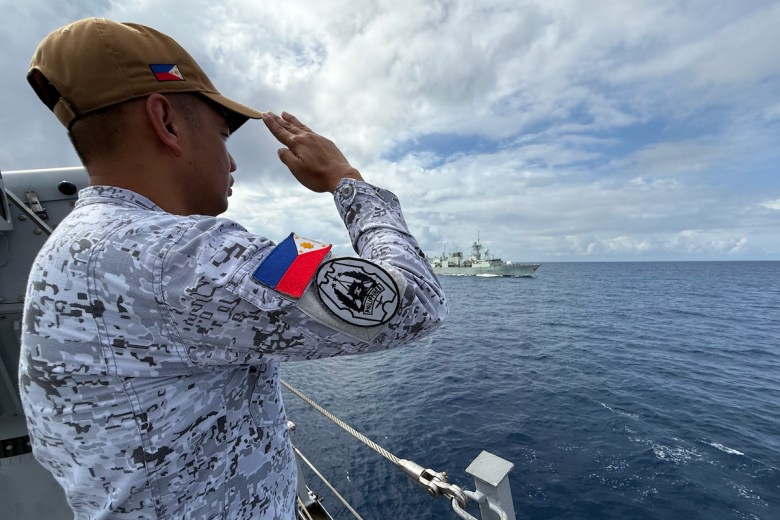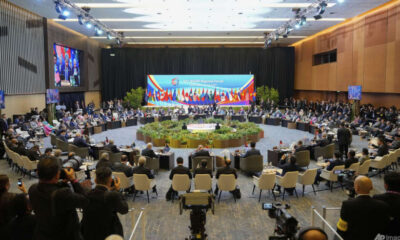Politics
Philippines, Australia, and Canada Strengthen Naval Cooperation in South China Sea

The Philippines, alongside Australia and Canada, conducted a joint naval operation near the disputed Scarborough Shoal in the South China Sea, demonstrating a unified stand against Chinese territorial claims. This two-day exercise, which concluded on September 3, 2023, involved the Philippine Navy’s BRP Jose Rizal (FF150), supported by the Australian HMAS Brisbane and Canada’s HMCS Ville de Quebec.
Scarborough Shoal, located just 232 kilometers (125 nautical miles) west of Luzon, has been under Chinese control since 2012 following a standoff with Philippine vessels. The shoal is a focal point in ongoing disputes, as China asserts extensive claims based on its controversial nine-dash line map. This operation underscores a growing willingness among middle-power nations to contest Beijing’s influence in the Pacific.
The drills included activities aimed at enhancing maritime domain awareness, coordinated operations, and a ship-to-ship transfer of personnel between Australia and the Philippines. A highlight of the exercise featured an Australian intelligence-gathering aircraft flying overhead while a disarmed submarine drone was deployed in the waters south of Scarborough Shoal. The exercise, labeled as a Coordinated Anti-Submarine Warfare Exercise, was designed to identify and respond to underwater threats.
Chinese vessels closely monitored the operation, with two ships from the People’s Liberation Army Navy (PLAN) observing the exercises. One PLAN ship, identifying itself as “warship 163,” instructed the participating vessels to maintain a safe distance. Chinese authorities later claimed that their presence was part of a “routine patrol” but criticized the joint drills as undermining peace in the region.
Filipino security analyst Chester Cabalza, who leads the Manila-based think tank International Development and Security Cooperation, remarked that the trilateral cooperation signifies a bold assertion of freedom of navigation rights. He noted, “Even without the United States in the equation, it conveys that every nation has the right to sail in Manila’s exclusive economic zone.”
The Philippine government views the exercises as a reaffirmation of its rights under international law, particularly in light of the 2016 arbitral ruling that favored Manila over Beijing’s expansive claims. While the United States remains a key ally, providing assurances of support in the event of armed conflict, Australia and Canada are increasingly engaging with the Philippines to bolster regional stability.
The recent exercises come on the heels of Exercise Alon, a major bilateral military drill between the Philippines and Australia involving approximately 3,600 personnel. This growing military collaboration reflects a strategic shift in the Philippines’ approach to its defense, particularly in the face of escalating Chinese aggression in the region.
In a statement about the exercises, Lieutenant Junior Grade Prince Charles Bauyot of the BRP Jose Rizal emphasized the importance of these drills for enhancing defense capabilities. He stated, “We are monitoring [Chinese vessels] and have challenged them multiple times,” highlighting that the exercises occurred within the Philippines’ territorial waters.
While the trilateral exercises marked a significant step towards a more coordinated approach among middle powers, analysts suggest that Australia is unlikely to enter into a mutual defense treaty similar to that of the Philippines and the United States. This existing treaty, established in 1951, has long provided a security framework in the region.
Cabalza noted, “Australia carves its own unique identity in its strategic partnership with the Philippines,” emphasizing Canberra’s evolving role as a reliable partner in the Indo-Pacific. As tensions in the South China Sea continue to rise, the collaboration among these nations signifies a concerted effort to uphold maritime law and regional sovereignty.
In conclusion, the joint naval operation near Scarborough Shoal represents a crucial moment for middle powers asserting their rights in contested waters. As the geopolitical landscape evolves, such exercises may pave the way for more robust cooperation among nations striving to maintain a rules-based order in the South China Sea.
-

 Lifestyle3 months ago
Lifestyle3 months agoHumanism Camp Engages 250 Youths in Summer Fest 2025
-

 Sports3 months ago
Sports3 months agoDe Minaur Triumphs at Washington Open After Thrilling Comeback
-

 Business4 months ago
Business4 months agoKenvue Dismisses CEO Thibaut Mongon as Strategic Review Advances
-

 Sports4 months ago
Sports4 months agoTupou and Daugunu Join First Nations Squad for Lions Clash
-

 Top Stories4 months ago
Top Stories4 months agoColombian Senator Miguel Uribe Shows Signs of Recovery After Attack
-

 World4 months ago
World4 months agoASEAN Gears Up for Historic Joint Meeting of Foreign and Economic Ministers
-

 Health3 months ago
Health3 months agoNew Study Challenges Assumptions About Aging and Inflammation
-

 Business4 months ago
Business4 months agoOil Prices Surge Following New EU Sanctions on Russia
-

 Entertainment3 months ago
Entertainment3 months agoDetaşe-Sabah Violin Ensemble Captivates at Gabala Music Festival
-

 Entertainment3 months ago
Entertainment3 months agoBaku Metro Extends Hours for Justin Timberlake Concert
-

 Business4 months ago
Business4 months agoU.S. House Approves Stablecoin Bill, Sends to Trump for Signature
-

 Top Stories4 months ago
Top Stories4 months agoRethinking Singapore’s F&B Regulations Amid Business Closures









